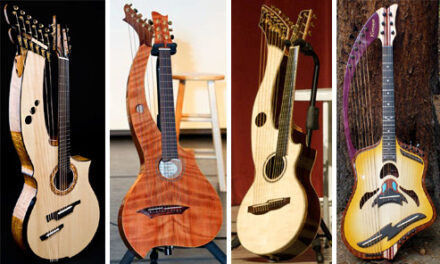 Merrill harp guitar #1 fitted with Rickard’s new state-of-the-art tuners.
Merrill harp guitar #1 fitted with Rickard’s new state-of-the-art tuners.
Actually, these weren’t technically invented for us, but they are going to be huge hit with harp guitar owners and players of the Dyer-style configuration!
Vintage Dyers and Knutsens, also – more on that in a minute.
As every schoolboy (and girl) knows, c.1900 harp guitars were fitted with friction tuners for their sub-bass strings (and sometimes the neck also). That’s only a 1:1 ratio, and they are notoriously difficult to keep from slipping. (Replacing the fiber washers will help, but they’re really hard to find).
So typically we’ve been swapping those out for 4:1 banjo tuners. Yes, banjo tuners. Despite the inevitable complaining, there is absolutely nothing wrong with them for sub-basses – at any gauge or tension. One simply has to keep the screw snug. If you change tunings often then the screws will eventually back off. Trust me, it won’t happen in the middle of a gig – it takes a long time. Crank too hard and you’ll eventually crack the plastic knobs. And 4-to-1 is a nice ratio for subs. Many professionals (Bennett, et al) and amateurs (me) have been using them without complaint for decades. For appearance, I have long preferred Stew-Mac 5-Star machines with Waverly ivoroid buttons (now “Galalith” at Stew-Mac). This gets you closest to the vibe and visual of the original friction tuners. Many banjo tuner brands work great: 5-Star, Waverly, Gotoh and others I’ve forgotten.
But now we’ve got idiot-proof 10-to-1 banjo tuners!
If you’ve heard the hype, believe it – and believe me now. Rickard Banjos kindly sent a set for evaluation and I couldn’t be more impressed.
As I understand it (from the man himself), the concept of a “cycloidal reduction drive” tuner was first prototyped by the legendary Frank Ford. He has a video that shows the assembly and operation. Kinda cool.
A few years later, after some discussion with Bill Rickard, Frank turned over his ideas to Bill, who has now patented his version of the cycloidal drive and started manufacture of the tuners that banjo players – and vintage guitar players, and harp guitarists – have all been waiting for.
Frank told me “they have a ten-to-one ratio, are perfectly smooth with no backlash, simply can’t slip and have no need for tension on the button.” I thought he was B.S.ing me until I tried them myself (this was after he assured me that he had tested them to maximum tension). So, you know that little end screw we have to keep so tight or the strings will slip? Forget about it! You can literally take it out and your heavy gauge low E sub-bass will still hold pitch!
My friend Randall Sprinkle was the first to manage to get a set to install on one of his problematic harp guitars. He loved them also. Mine (nickel plated; gold is also available) came with boxwood buttons, as I had asked about ivoroid to keep that vintage look (and they now have an ivoroid option). But now I’m actually sold on the wood buttons – as these are modern machines that I was putting on a modern instrument – Merrill #1. As I said, Stephen Bennett had no problem recording and touring with this instrument for years with its Stew-Mac tuners (and Waverly buttons, my exact preference by complete coincidence). But these Rickards are a serious upgrade. First is the no-more-slipping worry I already mentioned. No muss, no fuss – it’s incredible. Then the 10:1 ratio – being used to 4:1, I hardly needed it, but sure appreciate it! To change pitch a half step is still quick and easy; you turn two and a half times the distance and dial it in much easier and flawlessly. For subs, I’d say that it’s preferable to 16:1 gears.
There are a ton of new harp guitar instruments – and future designs – that might benefit from these, and I imagine Rickard will have a hard time keeping up with demand. Oh, your thick gauges? No problem. As we’ve been drilling out Stew-Macs, etc., we’ll drill out these. In fact, you won’t even have to; Rickard plans on doing it for us – pre-nickel plating even! For my strings of .050–.080”, they used two different drill sizes (.062”. and .093”).
Before I give you the link, here’s my direct comparison with the Stew-Mac 5-Stars next to a new Rickard 10:1 on the Merrill:
 Left: Stew-Mac 5 Star 4:1 (note ivoroid button beginning to crack from constant tightening); Right: Rickard 10:1 with basswood button
Left: Stew-Mac 5 Star 4:1 (note ivoroid button beginning to crack from constant tightening); Right: Rickard 10:1 with basswood button



And here’s a set of Rickard tuners mounted by Frank Ford on a 1931 OM-18, with original 1920s ivoroid buttons and a bit of “relic” treatment on the nickel-plated parts:

The only thing I altered was that I used the original Stew-Mac washer, as (see table) it is less heavy in visual appearance (they’ll consider reducing the size for the future). The Rickard screw heads and opposite shaft heads are similarly larger and more square, but fine. The housing is overall larger by a bit and 10% heavier than 5-Stars. Any set of 6 sub-bass tuners will weigh under half a pound either way. The 0.7 ounces extra per set that the Rickards weigh is negligible.
As I intimated above, I would probably stick to the Stew-Mac (with Waverly buttons) for my vintage instruments (which aren’t for the stage, and the tuners are already paid for), but switch to the Rickards for all modern instruments.
As now, I expect, will you!







This is excellent! I’ll be getting some of these. Thanks for the report, Gregg!